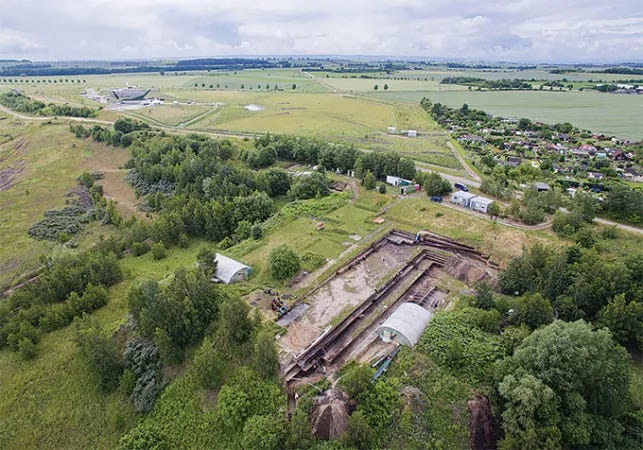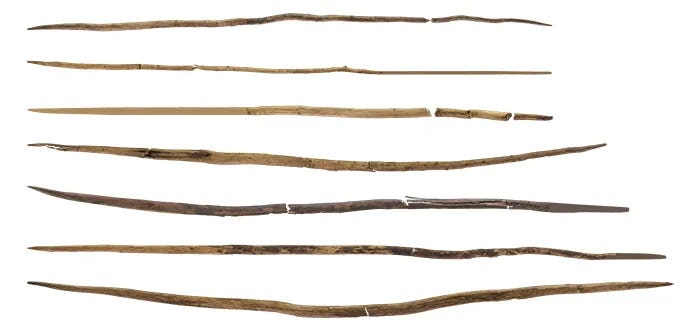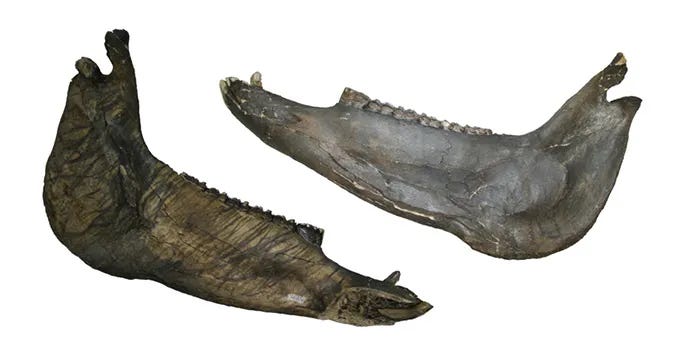The Marsh Ambush: What a 300,000-Year-Old Horse Hunt Reveals About Early Human Cooperation
A horse bone bed in northern Germany offers rare insight into the minds and methods of pre-modern humans—and how deep the roots of social intelligence may go.
On the edge of a shallow lake in what is now Lower Saxony, Germany, a group of hunters closed in on a herd of wild horses. It was late summer, perhaps early autumn, some 300,000 years ago. The animals had followed a familiar path through floodplain grasses to drink. As they reached the shore, something ancient stirred among the reeds.
Hidden there, armed with wooden spears, the hunters waited.
What unfolded next was no improvisation. It was a coordinated ambush—one requiring knowledge of terrain, animal behavior, and the actions of others. It may have ended in a moment of frenzy, with mares and foals brought down in muddy water, but it was conceived long before the herd reached the lake. It had to be.
This is the scene reconstructed by archaeologists from evidence at the site of Schöningen 13 II-4, where thousands of horse bones, butchered with precision and scattered in seasonal clusters, suggest that communal hunting—once considered a hallmark of Homo sapiens—was already well underway in the Middle Pleistocene.
“We’re looking at a highly structured social and cognitive event,” said zooarchaeologist Jarod Hutson of the MONREPOS Archaeological Research Center in Germany. “This wasn’t a matter of chance or instinct. It was cooperative planning.”
A Strategic Kill
The Schöningen horse site has been excavated for decades, but recent analysis1 of over 9,000 bones, including jaws, ribs, and long bones, has added depth to the story. The remains represent at least 54 wild horses, many killed in their prime and butchered for marrow, liver, and fat-rich tissue. Tool marks show deliberate dismemberment. Notably, there are few bones from adolescent horses—individuals who tend to break away from family groups and are harder to predict. This absence suggests that hunters intentionally targeted family herds, likely because of their consistent group behavior.
“Family herds are predictable,” said Hutson. “And that predictability made them vulnerable.”
Hunters exploited topography and group structure. Herd behavior was used against the animals. Lake mud became a trap. Juveniles slowed the group. Sentinels likely redirected the herd from higher ground. Kill zones were selected and prepared.

This was not the work of scattered foragers. It was an enterprise.
Weapons from a World Before Fire
Perhaps the most famous finds at Schöningen are the wooden spears—some of the oldest known in the world. Ten have now been recovered, along with dagger-like sticks, splitting tools, and over 1,500 stone implements. But there's no sign of fire. No hearths. No burned bones. If the hunters ate on-site, they likely consumed raw organ meats before transporting other parts elsewhere.

The spears, carefully carved and balanced, were not crude clubs. One, known as “Spear II,” measures more than 2 meters long, with a weighted base and tapered point—reminiscent of javelins used by athletes today.
“They understood aerodynamics, even if they couldn’t have named it,” said archaeologist Ashley Lemke, who studies ancient hunting strategies. “They were building tools with specific forms and purposes.”
More Than Survival
The hunting party at Schöningen may have included dozens of individuals—possibly men, women, and children—each with a role. Some drove the herd. Others delivered the kill. Still others butchered and distributed meat. If this sounds familiar, it should: similar strategies were observed among 19th-century Plains societies in North America and forager groups in sub-Saharan Africa.

“Communal hunting creates bonds,” said Eugène Morin, who has studied cooperative hunting among Indigenous groups across continents. “It’s about food, but it’s also about coordination, signaling, memory, and trust.”
Those intangible elements—the ones that don't fossilize—are what make Schöningen extraordinary. The bones hint at more than biology. They suggest anticipation. Division of labor. Perhaps even storytelling after the hunt.
A Wider Pattern Across Deep Time
Schöningen isn’t alone. Sites like Gesher Benot Ya’aqov in Israel (780,000 years ago) and Gran Dolina in Spain (400,000 years ago) also show evidence of systematic, group-based hunting. In Spain, Neanderthal ancestors drove bison off ledges. In Israel, prime-aged deer were repeatedly harvested from lakeshores.
In Germany, more recent Neanderthal groups left behind evidence of hunting elephants at Neumark-Nord—massive undertakings that required teamwork and foresight. Across these contexts, a pattern is emerging: early humans and their relatives hunted not as scattered opportunists, but as organized, tactical cooperators.
“They weren’t wolves or orcas following instinct,” said Antonio Rodríguez-Hidalgo, who has studied communal hunts at Atapuerca. “They were planning, strategizing. That kind of behavior demands symbolic thought.”
And perhaps even language.
Rethinking the ‘Modern’ in Human Behavior
For decades, archaeologists framed the emergence of modern human behavior as a sudden cognitive shift around 50,000 years ago. Art, ritual, language—all seemed to bloom at once. But the record now suggests a more gradual evolution, one that began hundreds of thousands of years earlier.
At Schöningen, no art has been found. No graves. No beads. But there is strategy, collaboration, and memory—a set of behaviors that, in many ways, define our species.
“The idea that planning, cooperation, and innovation belong only to Homo sapiens doesn’t hold anymore,” said Mark White of Durham University. “We’re seeing tactical, discerning, highly effective hunters in much earlier periods.”
Further Reading and Related Research
Morin, E., et al. (2024).
"Why do humans hunt cooperatively? Ethnohistoric data reveal the contexts, advantages, and evolutionary importance of communal hunting." Current Anthropology, 65(5), 876–921.
https://doi.org/10.1086/732354Rodríguez-Hidalgo, A., et al. (2017).
"Human predatory behavior and the social implications of communal hunting at Gran Dolina." Journal of Human Evolution, 105, 89–122.
https://doi.org/10.1016/j.jhevol.2017.01.007Gaudzinski-Windheuser, S., et al. (2023).
"Widespread evidence for elephant exploitation by Last Interglacial Neanderthals on the North European plain." PNAS, 120(50), e2309427120.
https://doi.org/10.1073/pnas.2309427120White, M., et al. (2016).
"Shoot first, ask questions later: Interpretative narratives of Neanderthal hunting." Quaternary Science Reviews, 140, 1–20.
https://doi.org/10.1016/j.quascirev.2016.03.004
Hutson, J. M., Villaluenga, A., García-Moreno, A., Turner, E., & Gaudzinski-Windheuser, S. (2024). Persistent predators: Zooarchaeological evidence for specialized horse hunting at Schöningen 13II-4. Journal of Human Evolution, 196(103590), 103590. https://doi.org/10.1016/j.jhevol.2024.103590










Share this post